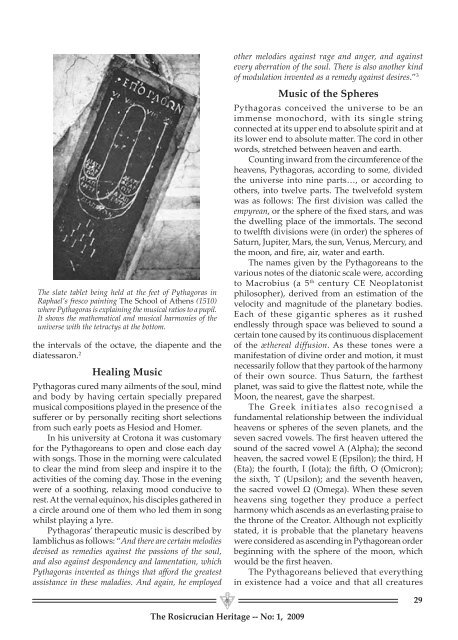Rosicrucian Heritage Magazine - 2009-03 - AMORC
Rosicrucian Heritage Magazine - 2009-03 - AMORC
Rosicrucian Heritage Magazine - 2009-03 - AMORC
Create successful ePaper yourself
Turn your PDF publications into a flip-book with our unique Google optimized e-Paper software.
The slate tablet being held at the feet of Pythagoras in<br />
Raphael’s fresco painting The School of Athens (1510)<br />
where Pythagoras is explaining the musical ratios to a pupil.<br />
It shows the mathematical and musical harmonies of the<br />
universe with the tetractys at the bottom.<br />
the intervals of the octave, the diapente and the<br />
diatessaron. 2<br />
Healing Music<br />
Pythagoras cured many ailments of the soul, mind<br />
and body by having certain specially prepared<br />
musical compositions played in the presence of the<br />
sufferer or by personally reciting short selections<br />
from such early poets as Hesiod and Homer.<br />
In his university at Crotona it was customary<br />
for the Pythagoreans to open and close each day<br />
with songs. Those in the morning were calculated<br />
to clear the mind from sleep and inspire it to the<br />
activities of the coming day. Those in the evening<br />
were of a soothing, relaxing mood conducive to<br />
rest. At the vernal equinox, his disciples gathered in<br />
a circle around one of them who led them in song<br />
whilst playing a lyre.<br />
Pythagoras’ therapeutic music is described by<br />
Iamblichus as follows: “And there are certain melodies<br />
devised as remedies against the passions of the soul,<br />
and also against despondency and lamentation, which<br />
Pythagoras invented as things that afford the greatest<br />
assistance in these maladies. And again, he employed<br />
other melodies against rage and anger, and against<br />
every aberration of the soul. There is also another kind<br />
of modulation invented as a remedy against desires.” 3<br />
Music of the Spheres<br />
Pythagoras conceived the universe to be an<br />
immense monochord, with its single string<br />
connected at its upper end to absolute spirit and at<br />
its lower end to absolute matter. The cord in other<br />
words, stretched between heaven and earth.<br />
Counting inward from the circumference of the<br />
heavens, Pythagoras, according to some, divided<br />
the universe into nine parts…, or according to<br />
others, into twelve parts. The twelvefold system<br />
was as follows: The first division was called the<br />
empyrean, or the sphere of the fixed stars, and was<br />
the dwelling place of the immortals. The second<br />
to twelfth divisions were (in order) the spheres of<br />
Saturn, Jupiter, Mars, the sun, Venus, Mercury, and<br />
the moon, and fire, air, water and earth.<br />
The names given by the Pythagoreans to the<br />
various notes of the diatonic scale were, according<br />
to Macrobius (a 5 th century CE Neoplatonist<br />
philosopher), derived from an estimation of the<br />
velocity and magnitude of the planetary bodies.<br />
Each of these gigantic spheres as it rushed<br />
endlessly through space was believed to sound a<br />
certain tone caused by its continuous displacement<br />
of the æthereal diffusion. As these tones were a<br />
manifestation of divine order and motion, it must<br />
necessarily follow that they partook of the harmony<br />
of their own source. Thus Saturn, the farthest<br />
planet, was said to give the flattest note, while the<br />
Moon, the nearest, gave the sharpest.<br />
The Greek initiates also recognised a<br />
fundamental relationship between the individual<br />
heavens or spheres of the seven planets, and the<br />
seven sacred vowels. The first heaven uttered the<br />
sound of the sacred vowel Α (Alpha); the second<br />
heaven, the sacred vowel Ε (Epsilon); the third, Η<br />
(Eta); the fourth, Ι (Iota); the fifth, Ο (Omicron);<br />
the sixth, Υ (Upsilon); and the seventh heaven,<br />
the sacred vowel Ω (Omega). When these seven<br />
heavens sing together they produce a perfect<br />
harmony which ascends as an everlasting praise to<br />
the throne of the Creator. Although not explicitly<br />
stated, it is probable that the planetary heavens<br />
were considered as ascending in Pythagorean order<br />
beginning with the sphere of the moon, which<br />
would be the first heaven.<br />
The Pythagoreans believed that everything<br />
in existence had a voice and that all creatures<br />
29<br />
The <strong>Rosicrucian</strong> <strong>Heritage</strong> -- No: 1, <strong>2009</strong>












